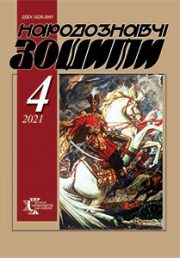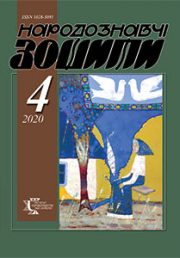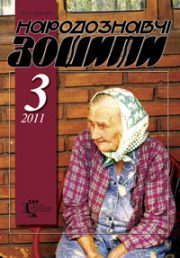For authors
Requirements to contributions predestined to be published
by “The Ethnology notebooks” magazine
The politics of open acces. The editorial board of the journal “The Ethnology Notebooks” is guided in its work by international ethical rules of scientific publications and adheres to the policy of open access to published material. Users can read, download, copy, distribute, print, search, or link to the full texts of articles in this magazine. The only restriction on reproduction and distribution and the only condition of copyright in this area should be the author’s right to control the integrity of his work and binding references to his name when using the work and its citation. This is in line with the definition of BOAI (Budapest Open Access Initiative) of open access [to reviewed scientific literature].
Full-text access in real-time to the scientific articles of the Magazine on the official site in the section Archive of rooms.
Rights and Responsibilities. The editorial board of the magazine is not responsible for the content of the publications and may not share the ideological beliefs of the authors. In terms of accuracy, the accuracy of the facts, citations and references is the responsibility of the author and reviewers.
The editorial staff reserves the right to minor edits and abbreviations, as well as literary correction of the text (preserving the main conclusions and style of the author). Texts that are not appropriate to the specified requirements are not accepted for publishing.
The editorial board has the right to refuse the publication of manuscripts containing already published data, as well as materials that do not correspond to the profile of the journal. The decision to publish is accepted by the editorial board and independent reviewers.
Reviewing.
The procedure for independent reviewing is provided by all articles submitted to the editorial staff of the magazine. Reviewers – scientists who carry out research in the specialty. The quality of research, originality, novelty, structure of the article is evaluated.
Neither the author nor the reviewers are given information about each other. The sent article sends (without the author’s name) to two selected reviewers who are experts in this field.
Review of manuscripts is conducted confidentially. The disclosure of the confidentiality of the review of the manuscript violates the rights of the author. Editors do not disclose information relating to the manuscript to anyone other than authors and reviewers themselves. Violation of confidentiality is possible only in the case of a statement of unreliability or falsification of materials, in all other cases, its conservation is mandatory.
Responsibility for infringement of copyright and non-compliance with existing standards in the materials of the article rests with the author of the article. The author and reviewers are responsible for the reliability of the above facts and data, the validity of the conclusions and recommendations made and the scientific and practical level of the articles.
Reviewers send reviews to the editorial board, the editorial board takes the final decision on publication based on the conclusions of the reviewers.
In the case of a negative review or substantial remarks, the article may be rejected or returned to the author (authors) for revision.
The final decision, along with comments from reviewers, is sent to the author.
Scientific articles, reports and revievs, documents and monuments, reviews for new publications, announcements about scientific events and events (conferences, exhibitions) in Ukrainian and English are accepted for publication. The magazine publishes original works that contain new scientific results. The author’s text should not be published before, and can not be a translation of a previously published article. The presentation must be clear, concise, without repetition. The text can not contain prohibited materials because the collection is an open source of information.
All materials should be sent to the e-mail address of the editorial office ethnolog@gmail.com
The text is submitted to the editorial office in the form of a file titled “Last NameAuto.doc”. SurnameAuthor — Latin letters, for example, petrenko.doc.
The text is typed in the Word for Windows editor in the .rtf, .doc, or .xdoc format.
The font is Times New Roman, the square — 14, the line spacing — 1.5, the margin — 2 cm, and the paragraph is 1 cm.
Volume — 10-30 pages, the number of illustrations — up to 20.
Pagination is sequential.
The text should use symbols based on the model: inverted commas (“…”), apostrophes (‘). The dashes in the text (long) must be separated from each side by spaces. Do not separate the mark of degree from the previous digit, percent (5°; 23%).
Separate an indissoluble space (simultaneously pressing Ctrl + Shift + Space) characters and letters to define volumes, parts, paragraphs, paragraphs, page numbers, etc. from the next digit (§ 1; T. 4; S. 5-50); common notation for measuring units from the previous digit (22 km; 50 UAH; 4 thousand); initials and surname (M. Hrushevsky); reduction after the lists (and so on, etc., etc.); before the geographical names (v. Strilky, the city of Rivne, the river Dnipro) and before the abbreviations of the pp., pp., art. Type 60s, 2nd types are printed through a non-breakdown hyphen (simultaneously pressing Ctrl + Shift + Dash). Time and numerical intervals are executed through a dash without spaces (January-February, 5-349).
The author’s comment should be made in round brackets with an indication through the dash of the author’s initials. Comment — in direct font, the initials of the author — italics.
Footnotes (explanations) should be submitted in a page with a cross-sectional Arabic numeration. Type size — 10. You cannot make footnotes to the title of the article, as well as to signatures to the illustrations.
Sources in the list of references are numbered sequentially in the order of their citation in the text. Each source cited in the work should appear in the list of used sources. Similarly, each entry in the list of used sources should be mentioned in the text of the work. The text of the link should be in square brackets with the numbers corresponding to their numbers in the list. Unsolicited references to unpublished materials are not allowed. Unwanted links to textbooks, encyclopedias, directories. References to sources in the text are presented in this way: [5, p. 12], where 5 is the source number according to the list of sources used, 12 pages. References to several sources at the same time are presented as follows: [1; 3; 14] or [2, p. 43; 8, p. 64; 12, p. 147]. Links to archival sources – [2, sheet 241, 217 back].
Each illustration (picture, drawing) must be submitted in a separate file. Illustrations in the middle of Word files are not accepted. Illustrations should be numbered according to their arrangement in the text, for example 01.jpg, 02.tif. In electronic form, illustrations should be executed in high quality, saved in formats * .tif, * .eps or * .jpg.
There must be a link to each illustration in the text.
Signatures for illustrations must be submitted in the text, at the very end, after the references, in the form: Illustration number – Signature. You can not make footnotes (links) to signatures to illustrations.
Tables should be numbered according to the order in which they are placed in the text and have a name. You need to type the table in the Word program. Notes and footnotes to the table should be printed directly underneath it. The font size of the text of the tables can be reduced (up to 8-10 pt).
There must be a link to each table in the text.
The scientific article should contain the following essential elements:
UDC index (note in the upper left corner);
through an interval in the upper right corner
block in the Ukrainian language:
the title of the article (the title of the article is printed in capital letters and bold in bold, the names of chapters in bold in bold at the end, the text from the new line, the additional subchapters — italics with a dot at the end of the title of the unit, the text in the same line). The name should not contain footnotes (references);
through the interval
name and surname of the author (authors) (small name, surname in capital letters);
ORCID code (http://orcid.org/) (required) (italics);
scientific degree, academic rank (italics);
position and place of work (not in italics);
e-mail (italics);
through the interval
annotation (the abstract should be abridged, should not repeat the title of the article, contain general phrases, duplicate the section “Conclusions”, do not contain quotations, have no footnotes). The abstract should briefly describe the subject, subject matter, purpose or subject of the research ( answer the question: what is being studied, what is analyzed, what is being analyzed, what is being considered, why the main focus is, what is the problem, what aspects does it touch);
through the interval
keywords — 5-10 words;
through an interval in the upper left corner
block in English (similar to Ukrainian):
article title;
name and surname of the author (authors);
ORCID code;
scientific degree, academic rank;
position and place of work;
e-mail;
abstract (Introduction, Problem Statement, Purpose, Methods, Results, Conclusion) 1800-2000 characters;
Keywords.
The article should be structured according to the following sections:
Introduction, which outlines the problem setting, the relevance of the chosen topic, the analysis of recent research and publications, the purpose and objectives of the work;
Presentation of the main research material with the full justification of the scientific results obtained;
Conclusions, which summarize the work and prospects of further research in this direction;
List of used sources with transliteration.
Before the list of literature, a list of abbreviations in alphabetical order need to be given.
References should consist of two parts: List of literatures and References.
List of literatures — sources in the original language, executed in accordance with the Ukrainian standard of bibliographic description (DSTU 8302: 2015: Bibliographic Reference, General Terms and Rules of Composition, Kyiv, 2016; ДСТУ 8302:2015: Бібліографічне посилання. Загальні положення та правила складання. Київ, 2016).
The List of literatures should include: for books — the author’s surname and initials, name, city, publishing house, year of publication, number of pages; for articles — the surname and initials of the author, the title, the title of the journal, the year and volume, the journal number, the beginning and end pages of the article.
You must add a digital DOI identifier (if any) to the source, for example: https://doi.org/10.15407/scin13.05.019.
Examples of designing references to literary sources
Articles in magazines
Парахіна М. Проблема повернення культурного надбання України в українсько-російських взаємовідносинах: з історії проблеми. Східноєвропейський історичний вісник. 2018. № 6. С. 8—14. DOI: 10.24919/2519-058x.6.123760.
Федорчук О., Куцир Т., Кумпікайтє Е., Мілашенє Д., Ненартавічютє Е. У пошуках етномистецької ідентичності: українсько-литовські студії (зустріч перша). Народознавчі зошити. 2018. № 2 (140). С. 333—338.
Books
Фольклорні записи Марка Вовчка та Опанаса Марковича. Київ: Наукова думка, 1983. 327 с.
Kožmínová A. Podkarpatská Rus. Práce a život lidu. Praha, 1992.
Mathews T.F. The Early Churches of Constantinopole: Architecture and Liturgy. University Park: Pennsylvania State University Press, 1971. 194 р.
Materials of conference
Цяо Шубей. Тенденции в проектировании детского игрового пространства в Китае. Педагогічні аспекти підготовки викладачів з візуального мистецтва та дизайну: сучасність і перспективи; Актуальні питання мистецтвознавства: виклики XXI століття: Збірник матеріалів Міжнародних науково-методичних конференцій (м. Харків, 9—12 жовтня 2017). Харків, 2017. С. 349—350.
Reviews
Конопка В. Комплексне дослідження традиційного житла Полісся. Народознавчі зошити. 2018. № 4. С. 1018—1019. Рец. на кн.: Радович Р. Поліське житло: культурно-генетичні витоки та еволюційні процеси. Львів, 2017.
Archives
Архів ІН НАН України, ф. 1, оп. 2, од. зб. 704, арк. 1—489. Серебрякова О.Г. Покуття (польові матеріали, зібрані в Коломийському, Снятинському, Тлумацькому, Тисменицькому, Городенківському р-нах Івано-Франківської обл., 2013, 2014, 2016, 2017 рр.).
Electronic resources of remote access
Наукові публікації і видавнича діяльність НАН України. Київ, 2007. URL: http://www.nas.gov.ua/publications (дата звернення: 19.03.2014).
Garfield E. More on the ethics of scientific publication: abuses of authorship attribution and citation amnesia undermine the reward system of science. Essays of an information scientist. URL:http://www.garfield.library.upenn.edu/essays/v5p621y1981-82.pdf (Last accessed: 16.04.2013).
References is a list of literature translated into English (or translated in the Roman alphabet) and is made in accordance with the American Psychological Association (APA) Style: http://nbuv.gov.ua/node/929. About the style also at https://ztu.edu.ua/ua/science/files/6_APA-style.pdf.
In transliteration, the requirements of the Cabinet of Ministers of Ukraine “On the Regulation of Transliteration of the Ukrainian Alphabet by Latin” of January 27, 2010, No. 55, should be observed. Only names of authors, names of cities, publishing houses, names of magazines, newspapers, organizations (if their names in English are not on official sites) should be translated.
In References, as in the literature list, you must add a digital DOI (if available) to the source and at the end of the original language (for example: [in Ukrainian], [in Russian], foreign – [in English], [in Polish] , [in German], etc.).
Take advantage of the transliteration program of the Ukrainian-language to Latin language free of charge can be found at http://litopys.org.ua/links/intrans.htm, and Russian-language text to Latin is available at http://www.translit.ru.
References should contain:
Description of the journal
surnames of all authors (between the surname and the initials, as well as between the co-authors’ names we put someone, and the last sign of the author);
year of publication of the article in parentheses () if the newspaper is a year, a
number, a month through a comma in round brackets ();
article title in English;
translate the name of the magazine (newspaper) in English (transliterated name of the magazine (newspaper), if there are no English names on the site) (name in italics);
the number of the magazine (italics) (volume, issue) and the page spacing by commas.
Book description
surnames of all authors (between the surname and the initials, as well as between
the co-authors’ names we put someone, and the last sign of the author);
year of release in round brackets () (before and after brackets the point);
translation of the name into English (after the title of the paragraph);
city;
publishing house (after the city in front of the publishing house a colon).
For a book without an author, you can specify the editor (s) (similar to the authors with an indication in parentheses (ed), (eds)).
For e-books after the title, we give a link to an electronic resource. Retrieved from:
For the section from the book after the authors and the year we submit: Title section. In the title of the book (page pp. Xxx-x). City: Publishing.
The report at the conference is presented as a section from the book.
Surname, Initials. (Year). Speech Name, Conference Information. Place of publication: Publishing house.
Multi-volume editions
Surname of the author of multi-volume work, Initials, & Editor’s Name, Initials (Ed.). (Year). The name of the multi-volume work (issue number). (Volume range). Place of publication: Publishing house.
For a separate volume
Last author’s name, Initials. (Year). Name it Initials Editor’s name (Ed.), Title of multi-volume work: Subtitled (edition number). (The number is therefore the page spacing). Place of publication: Publishing house.
Dissertations
Author. (year of publication). Title of thesis (Doctor’s or candidate’s). Access to it.
(For an unposted institution name). Required items to describe: PhD dissertation, Extended abstract of PhD dissertation, Master’s thesis.
REFERENCES examples
Articles in magazines
Konopka, V. (2013) Areal characteristics of the harvest caroling tradition in Ukraine. The Ethnology notebooks, 3 (111), 447-455 [in Ukrainian].
Books
Artiukh, L.F. (1977). Ukrainian folk cooking (Historical-ethnographic research). Kyiv: Naukova Dumka [in Ukrainian].
Williams, J. M. (ed.). (2016). Applied sport psychology: peak performance (5th ed.). Boston: McGraw-Hill.
Part of the book
Grosman, D. (2009). Writing in the dark. In T. Morrison (Ed.), Burn this book (pp. 22-32). New York, NY: HarperCollins Publishers.
Materials of conferences
Radovych, R. (2016). Development of the system of heating of Ukrainian Carpathians. Monuments of Tustan in the context of the development of the Carpathians in prehistoric times and in the Middle Ages; problems of their conservation and use (Proceedings of the 3rd International Scientific Conference). Lviv [in Ukrainian].
Separate volume of multi-volume edition
Tolstoy, N.I. (Ed.). (2012). Slavic antiquities: Ethno linguistic dictionary (Vol. 5). Moscow: Mezhdunarodnyye otnosheniya [in Russian].
Niehuis, S. (2008). Dating In J.T. Sears (Ed.), The Greenwood Encyclopedia of Love (Vol. 6, pp. 57-60). Westport, CT: Greenwood.
Dissertation
Radovych, R.В. (2018). Polissya dwelling: cultural and genetic origins and evolutionary processes. (Doctoral dissertation). Ivan Krypiakevych Institute of Ukrainian Studies of the National Academy of Sciences of Ukraine [in Ukrainian].
Dissertation abstract
Movna, U. (2017). Beekeeping: Ukrainian ritual contex. The thesis for the academic degree of the Doctor of Historical Sciences with a specialization in Ethnology. Lviv [in Ukrainian].
Radovych, R.В. (2018). Polissya dwelling: cultural and genetic origins and evolutionary processes. (Dr. hist. Sci. Diss. Abstr.). Lviv [in Ukrainian].
Archival document
Goroshko L.M. (2013). Field materials from Pokuttia (Kolomyjsky, Gorodenkivsky, Tlumatsky, Snyatinskyi district, Ivano-Frankivsk oblast). In Archive of the INNANU (Archive of the Institute of Ethnology of the National Academy of Sciences of Ukraine). F. 1. Op. 2. Od. save 698. Arc. 1-116 [in ukrainian].
Electronic resources of remote access
Scientific publications and publishing activities of the National Academy of Sciences of Ukraine. Retrieved from: http://www.nas.gov.ua/publications (Last accessed: 03/19/2014).
All materials should be sent to the e-mail address of the editorial office ethnolog@gmail.com






